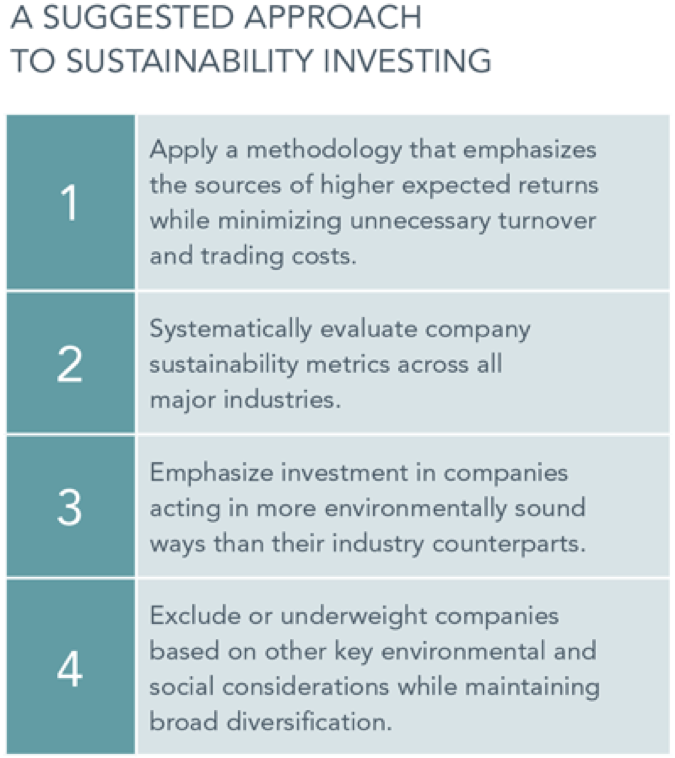Doing Well and Doing Good
Are investing well and incorporating values around sustainability mutually exclusive?
We possess the freedom to express our political preferences around sustainability through the ballot box. As investors, we also can express our preferences through participation in global capital markets. A client recently asked me how to implement her views without compromising her desired investment outcomes. Specifically, how to reduce her portfolio’s environmental footprint while maintaining sound investment principles and staying true to her investment objectives.

Source: Dimensional Fund Advisors, 2018
My recent client interaction wasn’t unique. Many clients have concerns about land use, biodiversity, toxic spills, operational waste, water management, and others. As their trusted financial advisor, my challenge is to achieve the dual goal of efficiently considering sustainability preferences while building investment solutions that align with their financial goals.
The process begins by evaluating companies through a holistic scoring system, rather than a binary “in” or “out” screening process. This approach enables preservation of diversification while recognizing those companies with favorable environmental profiles. The next step in the process is to look at companies across the entirety of a portfolio and within individual sectors, focusing on incorporating sustainability preferences while maintaining the integrity of the original mandate.
In this most recent client meeting, the objective was to reduce the client’s portfolio’s greenhouse gas emissions and potential emissions from fossil fuel reserves. Instead of immediately deemphasizing or excluding companies from the portfolio altogether, we performed an across-industry comparison. The exercise provided an efficient way to reduce the aggregate greenhouse gas emissions per unit of revenue produced by companies within the portfolio, with a minimal reduction in diversification.
The next step was to rate companies on sustainability considerations within each industry. This added level of scrutiny was recognition that, in the real economy, capital markets and the supply chain are highly interconnected. For example, a retail company may consume electricity from a utility company and transportation services from a trucking company, both of which are consumers of fuel from an energy company.
Through the comparison of companies within sectors, we recognized this interconnectedness and used the findings to overweight the most sustainable companies within a given industry. These findings included retail companies that improved the energy efficiency of their facilities, utilities that produced electricity using solar or wind power and trucking companies that developed greater fuel efficiency of their fleets (or utilized alternative-fuel vehicles). On the other hand, the companies with poor environmental sustainability ratings relative to industry peers received a lesser weight and in certain circumstances were excluded.
The combination of company selection and weighting allowed for a substantial reduction in exposure to greenhouse gas emissions and potential emissions from fossil fuel reserves—important goals for the client—while providing a robust investment strategy that was broadly diversified and focused on her initial investment objectives.
CONCLUSION
Investing well and incorporating values around sustainability need not be mutually exclusive. By starting with a robust investment framework, then overlaying the considerations that represent the views of sustainability-minded investors, it’s possible to implement a cost-effective approach that provides the ability to pursue sustainability goals without compromising on sound investment principles or accepting lower expected returns.
Michael Tanney
-Further Readings-
Our Current Reads – a list of the last 30 items (books, articles or blog posts) we found interesting: the right column on the HOME page, or under LIBRARY > OUR CURRENT READS.
Research – economics and finance research papers: under LIBRARY > RESEARCH.
-Photo Sources-
Cover: https://www.nasa.gov/sites/default/files/thumbnails/image/airquality3.jpg
